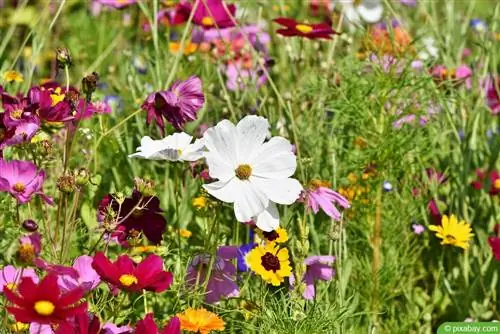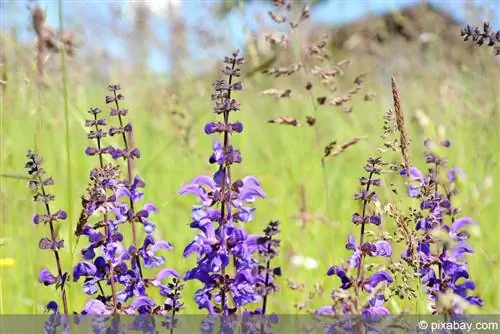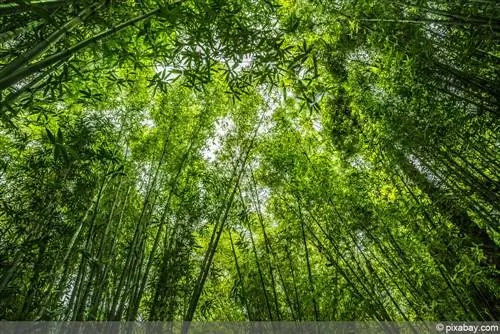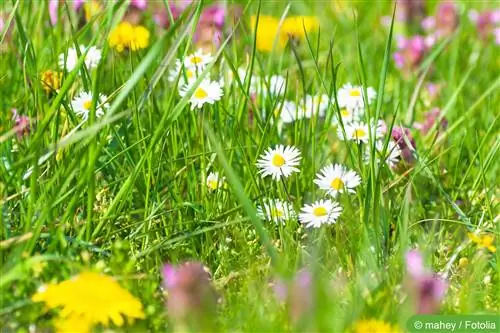- Author admin [email protected].
- Public 2023-12-17 03:39.
- Last modified 2025-01-24 12:45.
The properties of a flower lawn are convincing more and more hobby gardeners, so that flower-rich areas in the gardens are increasing. Not only nature benefits from this, but also people. The species-rich small biotope develops almost on its own. Only in the beginning should you pay a little more attention to the area and check whether the desired species develop.
What is a flower lawn?
Flower lawns are perennial, lower than flower meadows and consist of native wild plants. They grow to heights of between 40 and 50 centimeters and are an ecological and diverse alternative to sheared lawns or tall meadows. Special specialist markets sell seed mixtures that consist of around 80 percent wild grasses. These are less vigorous than sports turf grasses. Nevertheless, wild grasses also develop a thatch that allows for moderate foot traffic. The mixture is rounded off by around 20 percent of flowering plants that can prove themselves in the lawn and are also compatible with cutting. They are often typical species of poor meadows. Such a flower meadow impresses with its advantageous properties:
- relatively undemanding in terms of location
- need hardly any care
- can be entered
- set colorful accents
- increase biodiversity in the garden
Order regional seeds

Make sure that the seeds come from your region and are perennial. This way you can ensure that only native wild plants grow in your garden and that they bloom for many years. Regional seeds also have the advantage that the plants can cope optimally with the prevailing climatic conditions. This guarantees high germination rates and good growth success. A particularly wide range of species covers various site characteristics. In this way you ensure that the lawn adapts to the respective location. The plants that can best cope with the given conditions will bloom.
Consider possible locations
You can create the flower-rich lawn on any location where a conventional commercial or ornamental lawn grows. The colorful lawn mixtures grow in sunny locations with dry conditions as well as moist and slightly shaded areas. Sunny locations with loose and water-permeable soil promote optimal plant growth. If you sow the mixtures on poor sandy soil, more flowering plants will develop than grasses. The lawn remains patchy and proves to be less sturdy.
Prepare the area
If you plan to re-sow, the seedbed must be dug up and cleared of weeds. Remove the old turf and remove root residues of groundweed, dandelions and other unwanted weeds. Dig up the ground and break up any coarse clods of soil. Level the area with a wide piece of wood. Allow the soil to sit for a few days to settle. Unevenness is leveled out with a rake.
Tip:
Seedbed preparations should be completed at least one month before sowing. This allows soil life to normalize.
Wait for sowing time
You can create your flower lawn between spring and early summer, with the optimal period being from mid-April to mid-June. If you sow the seeds in March, they will have to wait for higher soil temperatures. In the meantime, unwanted herbs can already spread across the area. If you sow seeds too late, there is a risk that the seedlings will burn or dry out under the hot sun. Autumn sowing ensures a plant dominated by grasses. Flowering plants are then underdeveloped and do not survive the winter.
Tip:
If it is already too late to sow, you can protect the area from erosion and weed infestation with green manure that does not overwinter.
Stretching seeds
Before sowing, you should loosen the soil slightly, allowing the garden tools to reach a maximum depth of three centimeters. About six grams are spread per square meter. Since wild plant seeds are very fine, you should stretch the seed mixture with sand. Fine-grained and dry sandbox sand is ideal. For every four square meters of sowing area there is a liter of sand with the corresponding amount of seeds. Sowing is carried out in two steps to ensure even sowing:
- Walk the area in longitudinal lines and spread the seed-sand mixture
- then sow in horizontal lines
- Do not work the seeds into the soil, but rather tap or roll them
- do not reseed
Treat weeds properly
Immediately after sowing, the area is not irrigated so that the seeds are not washed away. Depending on the species composition, germination can take three months. During this time it is completely normal for unwanted weeds to appear. These are not weeded as this will damage the soil and allow the seeds to reach deeper layers of soil. As soon as the weeds have grown so high and dense that the ground no longer receives light, the area is mowed. Place the lawnmower on the top step or use a scythe. The crop is then transported away. You may have to mow several times during the sowing year.
Mow gently
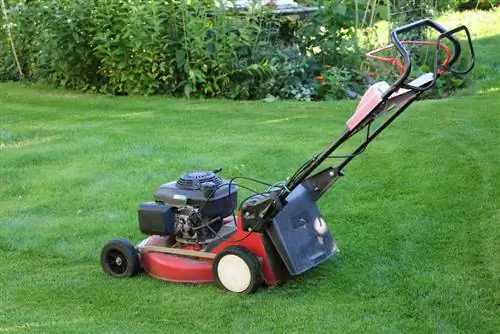
In the following years the lawn is mowed one to three times. The first cut is carried out as soon as the lawn has grown sufficiently high. If you mow before the first of May, leave a few daisy islands on the area. These are mown with the second mowing between the beginning and middle of June. The third mowing time depends on the growth. Adjust your lawn mower so that the area is trimmed to around eight to ten centimeters. So that the stock can recover quickly, you should not cut deeper than five centimeters.
Set care measures
The more nutrients and water the plants receive, the higher the care required. The increased growth means you have to mow more often. The turf becomes denser and can bear more loads. However, some flowering plants disappear as a result. To take full advantage of its biodiversity, you should neither fertilize nor water the lawn. This can result in a lean lawn that becomes more and more beautiful over the years.

